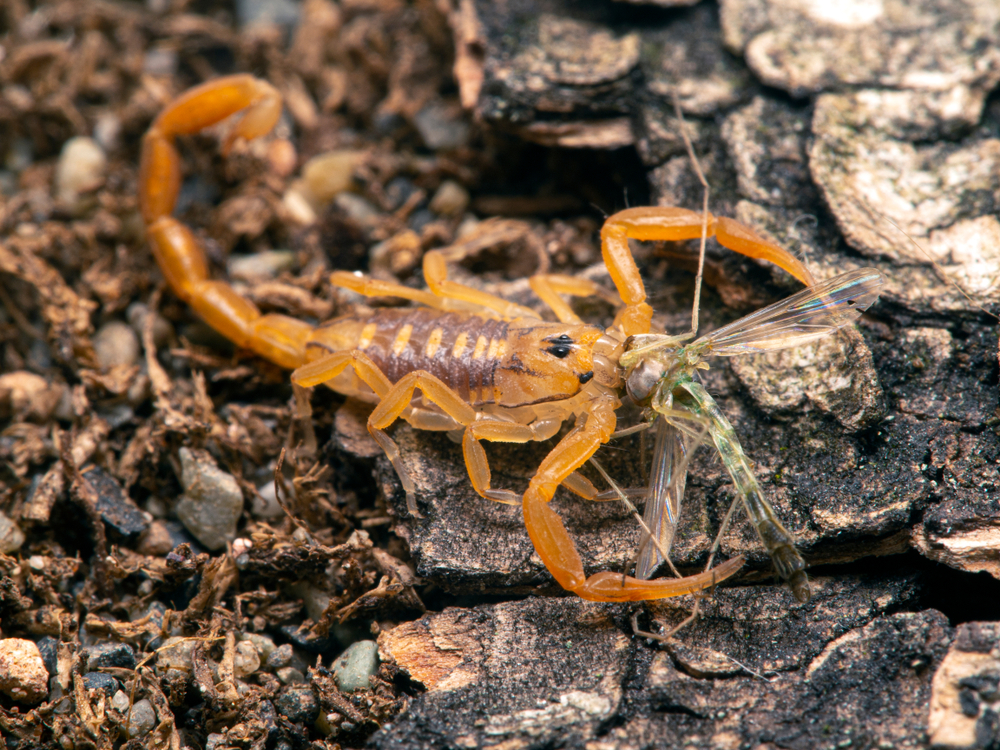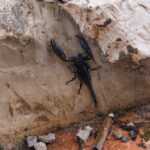Arizona Bark Scorpion: Safety Tips and Risks for Humans and Pets
The Arizona bark scorpion stands as the most toxic scorpion species throughout North America. This species is commonly found in southern Arizona and other parts of the desert southwest, where environmental conditions support high scorpion activity. Scorpions possess special features which classify them as members of the animal kingdom and fulfill essential roles in their natural habitats. This article explains scorpion behavior alongside methods to prevent bites and safety protocols for both humans and their pets.
Arizona Bark Scorpion: Safety Tips and Risks for Humans and Pets
The Arizona bark scorpion stands as the most toxic scorpion species throughout North America. Scorpions possess special features which classify them as members of the animal kingdom and fulfill essential roles in their natural habitats. This article explains scorpion behavior alongside methods to prevent bites and safety protocols for both humans and their pets.
- North American territory holds the Arizona bark scorpion as its deadliest scorpion species.
- The species stands out for producing excruciating stings which result in serious symptoms although they rarely result in fatal outcomes.
- Most stings from Arizona bark scorpions are painful but not life threatening, and long-term complications are extremely rare.
- Standard procedures to stop pest stings require home maintenance work including sealing entry points as well as personal safety precautions through suitable outdoor footwear and keeping pets inside during active scorpion hours.
- Local residents who want to protect themselves against scorpions can hire professional pest control specialists in Spring Valley for extra defense against the pests.
- People who find scorpions outdoors should recognize their living areas and follow established medical procedures when encountering stings. The treatment process includes washing the affected area followed by ice application while keeping track of any developing symptoms.
Understanding the Arizona Bark Scorpion
The southern desert regions of Arizona feature the notorious bark scorpions with the Arizona bark species (Centruroides sculpturatus) being the most prevalent. The species is well known for its dangerous venom. The scorpions reach lengths between 2 and 3 inches while possessing thin body parts with extended tail sections. The tail of these animals contains venom delivery mechanisms. The stinger functions as an adapted body part that lets the scorpion both hunt and defend itself through venom delivery to its prey. Arizona bark scorpions feed on a variety of small animals, including spiders and cockroaches, which are commonly found in their environment. The maximum length of Arizona bark scorpions reaches up to 3 inches when they become adults. The most venomous scorpion in North America delivers toxic stings to humans which need medical attention for proper treatment.
The Sonoran Desert arid terrain serves as the natural habitat where these dangerous yet interesting scorpions live. Arizona bark scorpions inhabit the desert southwestern United States and northwestern Mexico territories. Knowledge about their natural behavior and living environments helps reduce dangerous encounters.
The stripe tailed scorpion shares its preferred habitat with Arizona bark scorpions and can frequently be seen in human-made structures. Arizona bark scorpions demonstrate adaptability to human environments by commonly inhabiting residential areas. Cockroaches are also common household pests and may attract scorpions seeking food.
Nocturnal Lifestyle
Arizona bark scorpions begin their night activity after sunset when they leave their shelters to hunt crickets and roaches, as well as spiders. Their nighttime activities enable them to stay protected from the hot desert temperatures that exist during the day. The dark hours of night allow them to actively search for hidden prey in the darkness.
Arizona bark scorpions reproduce by giving birth to live young, a process known as birth to live young. These live young, called scorplings, climb onto their mother’s back immediately after birth and remain there until they complete their first molt, which marks their development towards independence. This stage helps boost their survival rates as they are vulnerable during early life.
One can observe this behavior by using UV light or black light during nighttime activities. Arizona bark scorpions become visible under ultraviolet light because their exoskeletons glow in the dark.
Climbing Abilities
The Arizona bark scorpion exhibits exceptional skills to climb straight up any surface. Their climbing ability enables them to penetrate homes by using foundation cracks or small breaches near windows and doors.
Because of this, people often encounter scorpions in unexpected places indoors, such as on walls, ceilings, or hidden in shoes and clothing, especially at night. Their climbing ability enhances the possibility of encountering human contact. The scorpions manage to access domestic spaces while finding shelter in unusual locations including wall spaces and ceiling areas. Arizona bark scorpions prefer to take shelter within hollow block walls. The walls serve as preferred daytime hiding spots while also functioning as primary points for scorpions to enter homes.
Seasonal Activity
The Arizona bark scorpion demonstrates seasonal behavioral patterns. Their peak activity period occurs during the summer months, specifically in July and August. Monsoon rains during this season contribute to increased scorpion activity, as the moist conditions and warmer temperatures create optimal conditions for their development and may cause scorpions to seek moisture or relocate to new harborage areas. Human encounters with scorpions tend to rise during the summer months because of these factors.
During the winter months, when temperatures decrease, these scorpions adopt a hibernation state that reduces their activity to a minimum. The scorpions seek protective covered spaces where they gather to survive the cold months. People who understand seasonal scorpion behaviors can protect themselves throughout the year from unexpected encounters.
The Sting of the Arizona Bark Scorpion
The Arizona bark scorpion stands as the most dangerous scorpion species that exists in North America based on venom toxicity. The venomous sting of the Arizona bark scorpion creates a severe health risk because it stands out from all other American scorpions as one of the most dangerous.
People who live in areas with these scorpions need to recognize the dangers their stings represent. Medical professionals consider Arizona bark scorpion stings as dangerous because they trigger severe reactions in the body. Individuals experiencing severe symptoms, especially children and the elderly, should seek immediate help from a medical professional for proper diagnosis and treatment. People who reside in the desert Southwest need to understand both preventive measures and scorpion-related awareness.
Most scorpion stings occur when humans accidentally touch scorpions that hide inside shoes or in bedding or out in the open. Most sting incidents lead to painful reactions yet they do not normally endanger human lives.
Venomous Sting
The venom from Arizona bark scorpions delivers a powerful burning sensation which produces intense pain that compares to an extreme bee sting. Both bee and scorpion stings cause sharp pain and swelling. The treatment for bee stings also applies to scorpion stings especially for elderly and child patients who are sensitive to pain. The venom delivered by scorpions can sometimes lead to worse symptoms than bee stings. The venomous bites of these scorpions typically produce long-lasting burning pain that may persist for many hours. Most scorpions sting people in Arizona without causing severe damage yet the resulting pain remains significant. The sting of an Arizona bark scorpion produces pain but does not lead to serious harm. The majority of Arizona scorpion sting cases result in temporary health effects even though the initial reaction from their intense nature is concerning.
After a bark scorpion sting wash the affected area with soap and water followed by an application of a cool compress to decrease swelling. Over-the-counter painkillers help manage symptoms and ease the immediate distress.
Symptoms of a Sting
The bite produces severe pain together with numbness and swelling which appears at the site where the sting occurred. The burning sensation can last a long time. The sting victim may experience numbness that begins at the sting location before spreading throughout their body to other areas.
The venom of Arizona bark scorpions produces intense pain yet it usually does not cause severe health problems in normal adult individuals. The analysis of reactions to scorpion stings requires individuals to check for symptoms. Medical attention becomes essential for treating severe symptoms.
First Aid and Medical Treatment
After receiving an Arizona bark scorpion sting you should start first aid treatment right away. Clean the sting area by using soap and water. Apply ice to the area to decrease swelling. The pain management process includes taking over-the-counter pain medication when needed.
Seek immediate medical attention if severe symptoms occur.
Safety Tips to Prevent Scorpion Stings
Preventing scorpion stings begins with understanding the methods to repel these dangerous animals. Basic housekeeping measures both inside and outdoors help minimize scorpion encounters. The Arizona bark scorpion species chooses to inhabit areas close to residences so homeowners need to take protective measures.
These guidelines help create a safer environment through home maintenance alongside personal safety and pet care measures.
Home Maintenance
Home maintenance that is proper serves as the main method to prevent Arizona bark scorpions from entering a house. Secure your home by repairing all structural holes and sealing any openings around doors and windows. The method prevents scorpions from entering. Scorpions seek shelter in cluttered spaces and trash so keep all areas free of these elements.
Check hidden spaces frequently while cleaning them to decrease the number of scorpion hiding spots. Place pet food dishes inside your home during nighttime because scorpions and other pests tend to be attracted to them. Adhesive traps serve as a secure way to capture scorpions while avoiding toxic chemicals.
Personal Precautions
When exploring scorpion-infested territories people should put on protective footwear to prevent getting stung. Use black light illumination for night exploration since it reveals scorpions that shine under ultraviolet light. Scorpions become visible under ultraviolet light which helps people detect them more easily. You should maintain a safe distance when watching scorpions. Stings become less likely when you stay away from scorpions.
Pet Safety
Your yard requires regular inspections to keep scorpions away from pets. Keep your pets inside your home when scorpions become most active during nighttime hours. Check the areas where pets rest and play regularly to stop scorpion stings.
The implementation of these steps significantly decreases the probability of pet scorpion stings.
Encountering Arizona Bark Scorpions Outdoors
Wild encounters with Arizona bark scorpions can be disturbing for most people. But being prepared helps. People are more likely to encounter scorpions during outdoor activities, especially when they accidentally disturb the scorpions’ natural hiding spots.
Recognizing Their Habitat
The Arizona bark scorpion population chooses to inhabit areas that are dark and cool. Scorpions prefer to hide beneath rocks and inside tree bark crevices and tight gaps. These creatures find their optimal habitat in riparian zones because such areas defend them against predators while providing climate protection. Knowledge of their locations enables you to stay away from scorpion-infested areas.
Arizona bark scorpions feed on insects and other insects, which are commonly found in debris and woodpiles. Your yard needs regular cleaning of all debris. Check rocks and woodpiles regularly to prevent scorpions from making their nests.
Safe Interaction
Maintain a safe distance from scorpions whenever you encounter them. Do not provoke it. Safe observation from a distance decreases the risk of receiving a defensive sting.
Most healthy adults tolerate stings without serious problems. Still, caution is advised.
What to Do If Stung Outdoors
Provide immediate first aid treatment when scorpion stings occur outside. Use soap and water to clean the affected area. Place ice on the affected area to decrease swelling. Over-the-counter pain medication helps to reduce discomfort. Elevate the sting area to minimize swelling.
Monitor your symptoms constantly. Seek immediate medical assistance if you experience severe pain together with breathing difficulties. Quick medical attention helps stop potential complications.
Eco-Friendly Scorpion Control Methods
Ecological methods for managing scorpions protect both the environment and minimize their population numbers. The use of humane and ecological practices helps deter scorpions while preserving the natural ecosystem. Natural predators such as lizards, birds, and bats hunt scorpions, which maintains an equilibrium in the food chain.
Several methods exist which include promoting natural predators and implementing sustainable pest management practices. The created environments remain free of scorpions through these methods while avoiding chemical usage. The existence of small lizards and bats helps control insect numbers, supporting a balanced ecosystem.
Natural Predators
The scorpion population is regulated by natural predators such as bats and grasshopper mice. Bats play a significant role in controlling scorpion numbers as part of the food chain. The natural population of scorpions remains stable through their predation by these species.
The presence of these predators near your house serves as an environment-friendly method for scorpion population management. An ecosystem with proper balance between species reduces scorpion encounters and supports biodiversity growth.
Frequently Asked Questions
Are Arizona bark scorpion stings deadly?
While Arizona bark scorpion stings can cause severe pain and symptoms, fatalities are extremely rare. There have been only two recorded fatalities in North America related to these stings, mostly involving young children or allergic individuals. Most healthy adults recover without serious complications.
How can I identify an Arizona bark scorpion?
Arizona bark scorpions are light brown and slender, typically measuring 2 to 3 inches in length. They have long, thin pincers and a narrow, segmented tail with a venomous stinger. They are also known to glow under UV or black light.
What should I do if I find a scorpion in my home?
Avoid direct contact and use a long tool or container to safely capture and release the scorpion outside if possible. Consider hiring professional pest control to inspect and treat your home to prevent further encounters.
Can pets be stung by Arizona bark scorpions?
Yes, pets can be stung, especially dogs and cats that explore outdoor areas. Stings can be painful and sometimes dangerous, so keep pets indoors during peak scorpion activity and inspect their resting areas regularly.
How effective are black lights in detecting scorpions?
Black lights or UV lights are very effective at revealing scorpions at night since their exoskeletons fluoresce under ultraviolet light, making them easier to spot and avoid.




